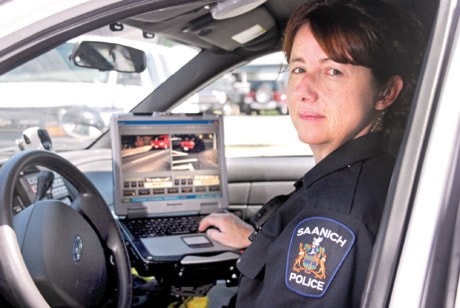Is Big Brother really watching you?
Three Victoria privacy advocates have spent the past two years trying to answer that question, digging up scraps of information on a controversial police technology called the automated licence plate recognition system.
Bดฮิชนูอ๘อ๘ึทWe have been stymied at every level,Bดฮิชนูอ๘อ๘ึท said Chris Parsons, a University of Victoria PhD candidate specializing in privacy issues.
The device uses police cruiser-mounted cameras to automatically capture up to 3,000 licence plates per hour. It then notifies officers of a Bดฮิชนูอ๘อ๘ึทhitBดฮิชนูอ๘อ๘ึท on uninsured and prohibited owners, as well as stolen vehicles.
The technology is used throughout British Columbia and is administered by the RCMP. In Greater Victoria, VicPD, Saanich police and the Integrated Road Safety Unit use it regularly.
What makes the program so concerning is critics say data collected from Bดฮิชนูอ๘อ๘ึทnon-hitBดฮิชนูอ๘อ๘ึท vehicles is kept on encrypted RCMP servers for two years. Although itBดฮิชนูอ๘อ๘ึทs not used, the information could be referenced for investigative purposes to retrace vehicle movements.
The RCMP insists such actions are not taking place, but the Mountie in charge of the program, Supt. Denis Boucher, said his office is considering expanding the program.
Bดฮิชนูอ๘อ๘ึทItBดฮิชนูอ๘อ๘ึทs called function creep,Bดฮิชนูอ๘อ๘ึท Parsons said. Bดฮิชนูอ๘อ๘ึทThat means every citizen that drives, (police) want to be able to track who they are and where theyBดฮิชนูอ๘อ๘ึทre at.Bดฮิชนูอ๘อ๘ึท
Parsons said the information is already being cross-referenced with child custody and other court records unrelated to driving infractions, but Boucher denies this.
Bดฮิชนูอ๘อ๘ึทIt doesnBดฮิชนูอ๘อ๘ึทt flag somebody simply because heBดฮิชนูอ๘อ๘ึทs got a criminal record,Bดฮิชนูอ๘อ๘ึท Boucher said. Bดฮิชนูอ๘อ๘ึทThese are for hits where we have outstanding action to be taken against an individual.Bดฮิชนูอ๘อ๘ึท
To resolve these concerns, Parsons and fellow researchers Bruce Wipond and Kevin McArthur submitted their findings to B.C.Bดฮิชนูอ๘อ๘ึทs Office of the Information and Privacy Commissioner, which set in motion an investigation into VicPDBดฮิชนูอ๘อ๘ึทs use of the technology.
Because the RCMP is outside of provincial jurisdiction, commissioner Elizabeth DenhamBดฮิชนูอ๘อ๘ึทs investigation is limited in scope to municipal police services.
Bดฮิชนูอ๘อ๘ึทThe investigation will look at general questions like what kind of information (VicPD) are collecting, how are they using it, is it retained or disclosed to anybody?Bดฮิชนูอ๘อ๘ึท said Cara McGregor, privacy commissioner spokesperson.
Saanich police purchased a plate reader of its own this year and it has been in operation for a couple months.
Sgt. Dean Jantzen said the device has Bดฮิชนูอ๘อ๘ึทproven its worthBดฮิชนูอ๘อ๘ึท in the time itBดฮิชนูอ๘อ๘ึทs been in operation. Bดฮิชนูอ๘อ๘ึทIt generates a lot of activity for our traffic safety officers,Bดฮิชนูอ๘อ๘ึท he said.
Jantzen, though not trained on the machine, reaffirmed that Bดฮิชนูอ๘อ๘ึทnon-hitBดฮิชนูอ๘อ๘ึท data is never used.
Bดฮิชนูอ๘อ๘ึทAs long as youBดฮิชนูอ๘อ๘ึทre not a suspended driver, that your licence is in good standing, that you have valid insurance, thereBดฮิชนูอ๘อ๘ึทs no reason youBดฮิชนูอ๘อ๘ึทll ever come into conflict with this device,Bดฮิชนูอ๘อ๘ึท he said.
DenhamBดฮิชนูอ๘อ๘ึทs report is due to be published next month and will be the first privacy review of the technology in Canada.
In a statement, VicPD Chief Const. Jamie Graham said Automated Licence Plate Recognition is an Bดฮิชนูอ๘อ๘ึทincredibly important application that directly contributes to improved road safety.Bดฮิชนูอ๘อ๘ึท
VicPD, which began using the program in March 2011, is co-operating with the investigation and has developed internal policies to govern the use of the device, department spokesman Mike Tucker said.
Bดฮิชนูอ๘อ๘ึท with files from Kyle Slavin and Jeff Nagel
dpalmer@vicnews.com



